Spanish house prices rising, foreigners buying, economy growing
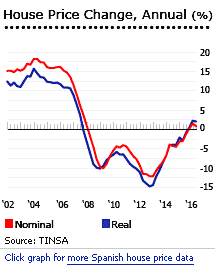 After almost seven years of falling house prices, Spain’s housing market is recovering. Spanish house prices increased 0.83% during the year to end-Q2 2016 (2.07% inflation-adjusted), its third consecutive quarter of y-o-y house price rises, based on figures from TINSA. The housing market finally returned to growth in Q4 2015. However quarter-on-quarter, house prices fell by 0.41% (-1.73% inflation-adjusted) during the latest quarter.
After almost seven years of falling house prices, Spain’s housing market is recovering. Spanish house prices increased 0.83% during the year to end-Q2 2016 (2.07% inflation-adjusted), its third consecutive quarter of y-o-y house price rises, based on figures from TINSA. The housing market finally returned to growth in Q4 2015. However quarter-on-quarter, house prices fell by 0.41% (-1.73% inflation-adjusted) during the latest quarter.
The Bank of Spain reports even stronger house price rises. During the year to end-Q1 2016, Spanish house prices rose by 6.34% (7.05% inflation-adjusted). On a quarterly basis, house prices increased 1.45% (3.58% inflation-adjusted) in Q1 2016.
Spanish house prices fell by a total of 41.4% (46.8% inflation-adjusted) from Q4 2007 to Q3 2015, based on figures from TINSA. There were 30 consecutive quarters of y-o-y declines:
- In 2008, Spanish house prices fell 7.71% (-9.86% inflation-adjusted)
- In 2009, house prices fell 6.88% (-7.07% inflation-adjusted)
- In 2010, house prices fell 4.03% (-6.4% inflation-adjusted)
- In 2011, house prices fell 7.64% (-10.11% inflation-adjusted)
- In 2012, house prices fell 12.05% (-14.67% inflation-adjusted)
- In 2013, house prices fell 8.31% (-8.48% inflation-adjusted)
- In 2014, house prices fell 4.45% (-3.92% inflation-adjusted)
- In 2015, house prices rose by a meagre 0.25% (0.53% inflation-adjusted)
In 2015, the total number of home sales in Spain increased 11% to 354,513 units from the previous year, according to the Instituto Nacional de Estadistica (INE). This rise in transactions was mainly driven by foreigners buying homes on the coast and in cities like Barcelona and on the Costa del Sol, one of the country’s most popular areas with overseas purchasers.
Britons remain the number one foreign homebuyers in Spain, making about 21% of all home purchases by foreigners in 2015, followed by the French, Germans, and Swedish buyers, each accounted for about 6% to 7%.
Foreclosures stood at 11,278 dwellings in Q1 2016, down by 14.7% from the previous quarter and down by 36.7% from the same period last year, based on figures from the INE.
Spanish house prices will increase by around 5% this year, according to a forecast by Moody’s credit rating agency.
In the first quarter of 2016, the Spanish economy advanced 0.8% from the previous quarter, the same as in the previous two quarters, despite political uncertainty after inconclusive general elections in December last year - the 11th consecutive quarter of growth. The economy is expected to grow by 2.6% this year and by another 2.5% in 2017, after growth of 3.2% in 2015 and 1.4% in 2014, and contractions of 1.7% in 2013, 2.6% in 2012 and 1% in 2011, according to the European Commission.
Local house price variations
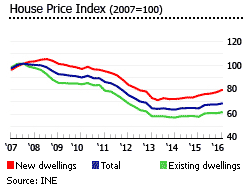
Most regions are showing remarkable improvement.
During the year to Q2 2016:
- In Andalucia, Spain’s largest autonomous community, house prices rose by 2.65% to an average of EUR1,125 per sq. m., according to TINSA.
- In Cataluña, the country’s second largest region, average house price increased 6.82% to EUR1,567 per sq. m.
- In Valencian Community, average house price increased slightly by 1.03% to EUR979 per sq. m.
- In Madrid, average house price rose by 5.37% to EUR1766 per sq. m.
- In Galicia, house prices declined 1.13% to an average of EUR1,047 per sq. m.
- In Castilla y Leon, average house price increased slightly by 0.62% to EUR981 per sq. m.
- In Canary Islands, average house price rose by 3.58% to EUR1,186 per sq. m.
- In Castile-La Mancha, average house price rose by 2.16% to EUR803 per sq. m.
Urban land prices continue to rise
Urban land prices in Spain rose by 5.3% from the same period last year in the first quarter of 2016, to an average of EUR157.70 per square metre (sq. m.), based on figures released by the Ministry of Public Works. Quarter-on-quarter, urban land prices rose 3.9% in Q1 2016.
The highest urban land prices were recorded in Madrid, with an average of EUR508.9 per sq. m., followed by Barcelona (EUR397 per sq. m.), and the Balearic Islands (EUR330.1 per sq. m.). In contrast, the lowest land prices were registered in Cantabria, with an average of EUR105.5 per sq. m., followed by Tarragona (EUR111.8 per sq. m.) and Asturias (EUR116.7 per sq. m.).
Land transactions in Spain rose by 7.2% to 3,716 units in Q1 2016 from the same period last year, according to the Ministry of Public Works.
From boom to gloom
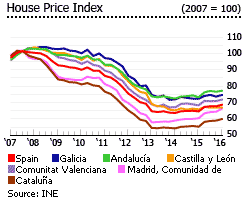
From 1996 to 2007, Spain’s national average house price rose by 197% (117% inflation-adjusted), one of Europe’s highest house price increases. The price of coastal properties surged 250% (155% inflation-adjusted) from 1996 to 2007, on average, as hundreds of thousands of foreigners, mainly from the UK, France and Germany, bought property.
In Madrid and Barcelona house prices rose 188% (109% inflation-adjusted) from 1996 to 2007, while prices in other inner provinces rose by 175% (101% inflation-adjusted).
The boom ended abruptly in 2008. The housing slump has battered the Spanish economy, and brought spiraling unemployment. Developers were left with blocks of unsold properties and massive debts. Uncertainty engulfed the market.
Transactions rising again
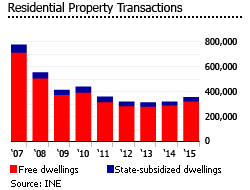
In 2015, the total number of home sales in Spain increased 11% from the previous year, to 354,513 units, according to the INE, mainly due to a surge in second-hand dwelling sales, which rose by 38.6% in 2015, to 277,127 units. However, new dwelling sales declined by about 35.2%, to 77,386 units.
During the first four months of 2016, home sales in Spain rose by 13.8%. Andalucia accounted for about 19% of all home sales in Spain in the first four months of 2016, followed by Cataluña (16%), Madrid (15%), and Valencian Community (14%).
Foreign demand continues to rise
Foreign investors started to return to the Spanish property market in 2014. In 2015, foreign homebuyers bought around 48,000 homes in Spain, up by more than 13% from a year earlier, based on figures released by Property Registrars. This represented about 13% of the total home sales in Spain.
Britons remain the number one foreign homebuyers, accounting for about 21% of all home purchases by foreigners in 2015, followed by the French, Germans, and Swedish buyers, each accounted for about 6% to 7% of all housing transactions carried out by foreign nationals. Chinese buyers are also increasing, representing around 4% of the total transactions.
The Golden Visa scheme, fully applicable since 30th September 2013, has resulted in increased interest not only from the Middle East but also from Asia and Russia. Under this system, any non-EU national bringing more than EUR 500,000 (USD689,700) to invest is automatically granted a Spanish residency permit.
From October 2013 to December 2014 the Golden Visa scheme attracted 531 applicants, mostly Chinese and Russians. Spain has received more than EUR 700 million in foreign investment as a result.
The Balearic Islands are especially attractive to foreigners with more than 40% of total demand coming from foreigners. This is followed by the Valencian community with 35% foreign demand; Canarias with 34%; and Murcia with 24%.
Spain’s ‘bad bank’ SAREB might need recapitalization
For several years prior to 2008, low borrowing costs fuelled a speculative housing bubble in Spain, masked by the initial growth. Following the crash, in August 2012 SAREB - Spain’s “bad bank” - (Sociedad de Gestión de Activos procedentes de la Reestructuración Bancaria) was founded to separate problematic assets from the balance sheets of weak credit institutions. About EUR 55 billion (USD 75.84 billion) has been transferred to it from nationalized Spanish financial institutions: BFA-Bankia, Catalunya Banc, NGC Banco-Banco Gallego and Banco de Valencia; and from banks that have required medium-term financial aid.
In 2015, SAREB unveiled a loss before tax amounting to EUR472 million, down from a loss of EUR1 billion in 2014. SAREB sold only 11,256 real estate assets in 2015, including homes and undeveloped land, 26% down from a year earlier. SAREB continues to offload assets transferred from the country’s ailing saving banks. While things are improving, “the risk of further recapitalisation needs cannot be ruled out,” said the European Commission.
Spanish interest rates are amazingly low
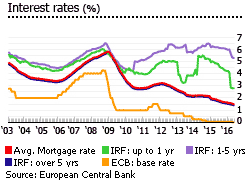
The great Spanish housing boom was fuelled by 15 years of dramatic reductions in mortgage interest rates, from 17% in 1991, to 10%–12% (1995 to 1996), to below 3.5% (2004 – 2005) - among the lowest rates in Europe.
Following post-crisis European Central Bank (ECB) key rate reductions, the average mortgage rates in Spain dropped to 2.61% in December 2012, to 2.11% in December 2013 and to 1.89% in December 2014. In April 2016, the average mortgage rate in Spain stood at 1.41%, according to the European Central Bank.
- The interest rate for housing loans with initial rate fixation (IRF) of up to 1 year stood at 2.79%, significantly down from 4.84% a year earlier.
- The interest rate for housing loans with IRF between 1 and 5 years was 5.28%, down from 6.15% a year earlier
- The interest rate for loans with IRF of over 5 years was 1.4%, down from 1.77% a year earlier.
Spain’s housing market is extremely vulnerable to interest rate changes, due to the use of adjustable rate mortgages. More than 80% of new mortgages have had initial rate fixations (IRF) of less than 1 year since 2004 (more than 90% of new loans from 2005 to 2006). In 2010, about 86% of new mortgage loans had an IRF of less than a year; in 2011, about 82%; in 2012, about 78%; in 2013-14, it has moderated to around 68%. Then in 2015, about 62% of all new mortgage loans have IRF of less than 1 year, 26% with IRF of 1-5 years, 4% with IRF of 5-10 years, and 8% with IRF of over 10 years.
New mortgages are rising
Since peak levels in 2006, when 1,342,171 new home mortgages were granted, mortgages granted in Spain have fallen by 82%. Now this is turning around. In 2015, there was a 21% surge in new home mortgages, a sharp improvement from a meagre increase of 1.6% in 2014.
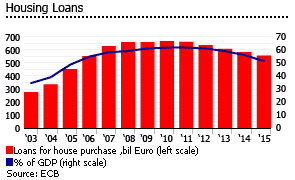
Mortgages totals are still falling because of the large downturn in new grants during the crisis. In 2015, the Spanish mortgage market contracted to about 51.25% of GDP, down from 61.54% in 2011, according to the European Central Bank (ECB).
Almost 30.8% of the home purchases were transacted in cash last year.
Rents rising, yields recovering
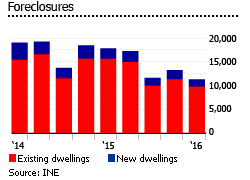
Average apartment rents in Spain rose by 3.6% in 2015, according the real estate portal Fotocasa. Rent increases were seen in almost all regions. Cataluña saw the highest annual increase in rents, up by 10.7%.
In Barcelona, the average rent stood at EUR13.3 per sq. m. per month. All Barcelona´s 10 municipalities experienced rent increases in 2015.
In Madrid, rents also increased 6.5% in 2015 from a year earlier, to an average rent of EUR11.2 per sq. m. per month. Rents rose in all the capital’s districts, the first time in nine years.
Spain´s rental market reached its peak in May 2007, when rents stood at EUR10.12 per sq. m. per month, according to Fotocasa. Over the past eight years rents dropped almost 31%. The biggest declines were in Aragón (-40.6%), Cantabria (-36.1%), Castilla-La Mancha (-35.5%), Valencia (-34.4%) and Murcia (-32.3%).
“In general, prices will stabilise in 2016 because the rental market is here to stay in Spain," said Fotocasa. "But its evolution will continue to be very uneven, with rental prices continuing to rise in the main cities on the one hand, but continuing to fall in smaller towns and in neighbourhoods on the outskirts, as well as in regions with low economic activity”.
Gross rental yields in Spain are slowly recovering, according to Global Property Guide research conducted in July 2014. Yields are still not high enough to make buying an apartment attractive from the yields perspective, but are better than previously.
The gross rental yield for apartments in Barcelona ranges from 3.80% to 4.70%, whereas in the centre of Madrid, rental yields are better, ranging from 3.91% to 4.92%. In Madrid-suburbs, rental yields range from 4.11% to 4.87%.
Housing glut should be cleared by 2018

The oversupply of homes reached its peak in 2010, when the surplus stock amounted to 931,615 homes, according to the Institute of Business Practices (el Instituto de Práctica Empresarial or IPE). Partly due to strong demand, the surplus of homes fell by 41% from 662,761 homes in 2014 to just 389,000 homes in 2015.
This year, housing glut is expected to fall to under 350,000 homes, according to APCE association of property developers.
“It is clear that demand is up, mortgage lending is growing, and the price of property that people actually want to buy is stable or rising,” said Mark Stücklin of Spanish Property Insight. “However, there is still a vast glut of homes built in the wrong place for which there is little demand.”
Almería is the province with the highest level of excess housing stock, with 38.9%, followed by Cuenca (37.1%), Castellón (36.1%), Toledo (34.7%) and Murcia (32.7%), according to TINSA.
In contrast, Álava is the province with the smallest proportion of unoccupied homes, with only 10.3%, followed by Guipúzcoa (15.2%) and Navarra (17.6%).
The degree of overbuilding can be guessed at by looking at the number of housing starts from the National Statistics Institute (INE):
- From 1990 to 1996, an average of 240,000 dwellings were started annually.
- Between 1999 and 2002, with house prices rising rapidly, dwelling starts exceeded 500,000 units annually, rising to 650,000 annually 2003 – 2004
- In 2006, dwelling starts exceeded 700,000
- In 2007 commodity price rises brought rising costs – and starts slowed to 615,976.
- A drastic decline followed. There were just 328,500 dwelling starts in 2008, and 159,286 in 2009. In 2010, there were 123,616 dwelling starts.
- In 2011 starts declined to only 86,252, and in 2012 to 50,000.
- Dwelling completions followed a similar path. Despite the massive oversupply, dwelling completions exceeded 630,000 in 2008, most units having been started before the crisis. In 2009, dwelling completions dropped to 424,000. In 2010, completed dwellings stood at 276,883. A further decline in 2011 with only 179,351 dwellings completed. Only 133,415 dwellings were completed in 2012.
Tinsa believes the housing glut will be cleared by the first half of 2018 and new constructions will pick up in areas with high absorption rates to avoid shortages. These include Madrid, Barcelona, Malaga, Granada, Girona, Oviedo, Santander, Vigo, Pontevedra, San Sebastian, Gijon and Aviles.
Spanish economy continues to grow

Spain’s economy started to recover in 2014, with GDP expanding by 1.4%, according to the International Monetary Fund (IMF). In January 23, 2014, Spain became the second euro zone country to exit its international bailout program, after Ireland. The economy grew by a healthy 3.2% in 2015.
In the first quarter of 2016, the economy advanced 0.8% from the previous quarter, the same as in the previous two quarters, despite political uncertainty after an inconclusive general elections in December last year - the 11th consecutive quarter of growth.
It has been a long, hard slog. Recession has been Spain’s normal condition for years. The economy shrank by 1.7% in 2013, according to the IMF, by 2.6% in 2012 and by 1% in 2011. In 2010, the economy grew by a meager 0.02%, after a contraction of 3.6% in 2009.
The economy is expected to grow by 2.6% this year and by another 2.5% in 2017, according to the European Commission.
Spain’s economy was fuelled by property during the boom decade from 1997 to 2007. At the height of the housing boom in 2007, housing investment was no less than 7.5% of Spain’s GDP, significantly above the OECD average. The construction industry became a key employer of low-skilled workers. The increase in construction activity helped pull unemployment down from 24% in 1994, to 8.3% in 2007.
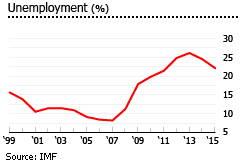
With the situation reversed, Spanish unemployment now stands at 21% in Q1 2016, down from 23.8% in Q1 2015 and 25.9% in Q1 2014, according to the INE. Despite this, Spain’s unemployment is still the second highest in the OECD, next to Greece. The country’s overall unemployment rate is expected to be 20% at the end of 2016 and to fall further to 18.1% in 2017, according to the European Commission.
In June 2016, consumer prices fell by 0.8% from a year earlier, from annual declines of 1% in May, -1.1% in April, and -0.8% in February and March 2016, according to INE. Annual inflation is expected at 0.1% this year, from -0.6% in 2015, and -0.2% in 2014, according to the European Commission.
Spain narrowed its budget deficit last year to 5.1% of GDP, down from 5.9% in 2014 and 7% in 2013 still higher than the target deficit of 4.2% of GDP. Due to its failure to meet its target, the European Commission has recently proposed to fine it, together with Portugal, in an effort to enforce rules designed to avert another debt crisis. Should the recommendation be approved, fines can reach as high as 0.2% of GDP and a suspension of some regional funds.
The deficit is projected to fall to 3.9% of GDP this year and to 3.1% 0f GDP in 2017.
Spain’s gross public debt stood at about 99.2% of GDP in 2015, a slight decline from 99.3% of GDP in 2014. It is expected to increase further to 100.3% of GDP this year, according to the European Commission.